SSCI-581-Week4
Spatial Representation and Power
The Authority of Maps
- Maps are read as authorities; they are difficult to create and mapmakers have technical skill; people trust what they see in maps
- But mapmaking is not objective; many choices must be made. What to map and how to map it are choices
- Culture is embedded in maps, such as ideas about the nature of land and human society
- Propaganda(宣传;鼓吹) maps are extreme examples
Land Areas and Epistemoloty
- We see maps as evidence of physical world
- The appearance of land area on a map will be distorted in some way
- The widespread use of the Mercator projection in Western countries distorts our idea of continental size
Maps as Propaganda
- Linking national boundaries and evocative imagery is used pre-war and during wartime to stir up nationalist sentiment
Spatial Knowledge Over Time
Age of Exploration 15th & 16th C.
- Navigation: sustained use of astronomy
- Ships: merging maneuverability and strength
- Cartography: from mappa mundi to practical maps
- World coastlines were mapped
- oceans became the means and paths to discovery
- The growth and Portuguese and Spanish colonial empires
Enlightenment - 16th & 17th C.
- Cultural thirst for new maps and descriptions of faraway places
- The growing authority of maps
- Intellectual shift: acceptance of the scientific method and physical reality of sources of true knowledge rather than received authority
Age of Discovery - 18th & 19th C.
- Scientific Travel - Voyages to chart the natural world, with political ambitions to expand empire and catalogue resources
- 1768 Transit of Venus expeditions
- Lewis and Clark expedition (1804-06)
- Voyage of the Beagle (Darwin’s exploratory voyage)
- Scientific, commercial, and military linkages
- The 18th and 19th centuries were era of cataloguing knowledge
- Local history and geology
- Colonial resources
Geography and Imperialism - 19th & 20th C.
- Linking of race, climate, and imperialist arguments
- Americans used maps and state laws for registration of land titles to shift land titles to shift land possession and/or ownership from Native Americans and Mexicans to new Americans
Spatial Knowledge - 20th C.
- Technical advances
- 1st half of the C.: photography, air travel, and navigation
- 2st half of the C.: radar, satellites, geolocation, computers, internet, GIS, …
- Global military and commercial competition spurred the advances
- First and second world wars
- Cold war
- Colonial empires replaced by commercial linkages
Spatial Knowledge - 21th C.
- Technological Advances
- GIS
- Satellites and GNSS
- Remote Sensing
- LBS-enabled devices
- Mobile apps employing LBS
- Cultural shift
- Widespread smartphone ownership
- Sharing of data
The Power of Maps and Spatial Data
- Power of spatial data - detailed knowledge about a place
- Can exert power over space, extract value from a place
- Gain knowledge/power of inhabitants
- Power of maps - spatial information with visualization
- Archives of spatial information
- Communicators of spatial information - draw on visual to enhance spatial knowledge
- Visual imagery - propaganda/cultural knowledge
- Spatial data and maps are complicated and difficult to collect/archive/create
Critical GIS
GIS & Society Debates
- In the 1990s scholars noted a problematic contradiction underlying the growth of GIS:
- Spatial data and its analysis was growing in importance, but
- The data was largely out of public reach
- The tools were largely out of public reach, and
- The analytical methods were not being taught
All articles in this blog are licensed under CC BY-NC-SA 4.0 unless stating additionally.
Comment


